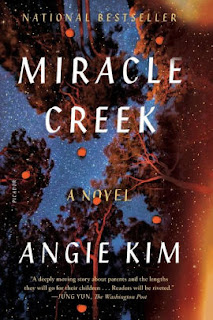The Jersey Brothers: A Missing Naval Officer in the Pacific and
His Family's Quest to Bring Him Home
Author: Sally Mott Freeman
Publisher: Simon and Schuster
Date of Publication: May 9, 2017
Pages: 608
The Jersey Brothers was selected for monthly discussion
by our neighborhood non-fiction book group. I had never heard of the book
before it was selected and doubt that I ever would have stumbled upon it to
read on my own. I am glad that our group selected it, as the book is
obsessively researched, tightly written, emotional in many areas, and, on top
of all of that, very educational.
The story
is about two brothers, Bill and Benny Mott, and their younger
half-brother Barton Cross. The focus is mostly on Barton who was taken
prisoner by the Japanese after the fall of the Philippines. The early
part of the book relates much of Barton's upbringing and schooling. The
reader is also introduced to the boys' mother Helen, who becomes a major
character as the book moves along. Bill and Benny are achievers, each
obtaining an appointment to the Naval Academy in Annapolis and going on to
successful naval careers. Barton has a flair for the arts and music and
doesn't seem to have the same drive to succeed. He is sent to a private
boarding school for high school to try to improve his academic standing but is
not offered a position in Annapolis. He spends a year at The Citadel in
Charleston, S.C. instead. He survives all the hazing and harsh treatment
as a first-year cadet. Succeeding at The Citadel he transfers to the
Naval Academy, where he endures yet another year of hazing and brutal physical
punishment. He proceeds to fail a math class by a fraction of a point and
winds up at the University of North Carolina in Chapel Hill. He graduates
from there with a business degree. The point of all this backstory
regarding Barton is important for the reader to know since these experiences
were very formative and explain how he could survive the ordeals inflicted by
his Japanese captors. The reader also sees Helen Cross as a manipulative and obtrusive parent, what today we would call a "helicopter
parent". She embarks on letter writing campaigns every time she
perceives that her son has been mistreated.
Meanwhile,
Bill becomes an attorney and then, as a naval reservist, becomes a Naval Intelligence officer. Benny moves
up the ladder of command at sea. As World War II approaches, Bill,
recognizing that Barton will inevitably be drafted into the Army, pulls strings
and gets Barton into the Navy as a supply officer. Bill figures that this
arrangement will keep Barton out of harm's way. Unfortunately, exactly
the opposite occurs as Barton is in the wrong place at the wrong time as the
Japanese overwhelm the Philippines.
What follow
is the story of Bill and Benny's relentless pursuit of information pertaining
to their imprisoned brother and Barton's horrific ordeals at the hands of his Japanese captors. Bill uses his position as chief of the White
House Map Room (the war room) and his close relationship to President Roosevelt
to gain access to classified prisoner and casualty lists. Benny gets
closer and closer to the Philippines as the U.S. Navy moves across the many
Pacific islands as the war progresses. These brothers collectively are
witnesses to most of the pivotal events of the Pacific war: the attack on Pearl
Harbor, the naval battles at Coral Sea and Midway, the Doolittle raid, and the
utilization of the atomic bomb. The author also exposes the infighting between
the Army and Navy over strategy and the personal battles between General
Douglas MacArthur and Admiral Chester Nimitz.
This book
is important for many reasons, not the least of which is that it highlights the intense emotional toll
that war has on families. The unraveling of marriages, the disruption of
any sense of normalcy, and, especially poignant, the terror inflicted on family
members of prisoners of war. Using Helen's diary entries and her many
letters to naval officers, congressmen, and even President Roosevelt, the
author shows the psychological damage inflicted on those at the home
front.
In the end,
The Jersey Brothers is an exhaustive look at World War II through the eyes of a
remarkable family and their many contributions to the war effort. The
author is the daughter of Bill Mott, and she has obviously poured her heart and
soul into this work. She brings the horror of war down to a very personal
level; Bill, Benny, and Barton are presented as the heroes that they indeed
were, but with all their humanity, doubts, failings, and inadequacies presented
as well. The Jersey Brothers is a remarkable achievement and one which I
will not soon forget.










